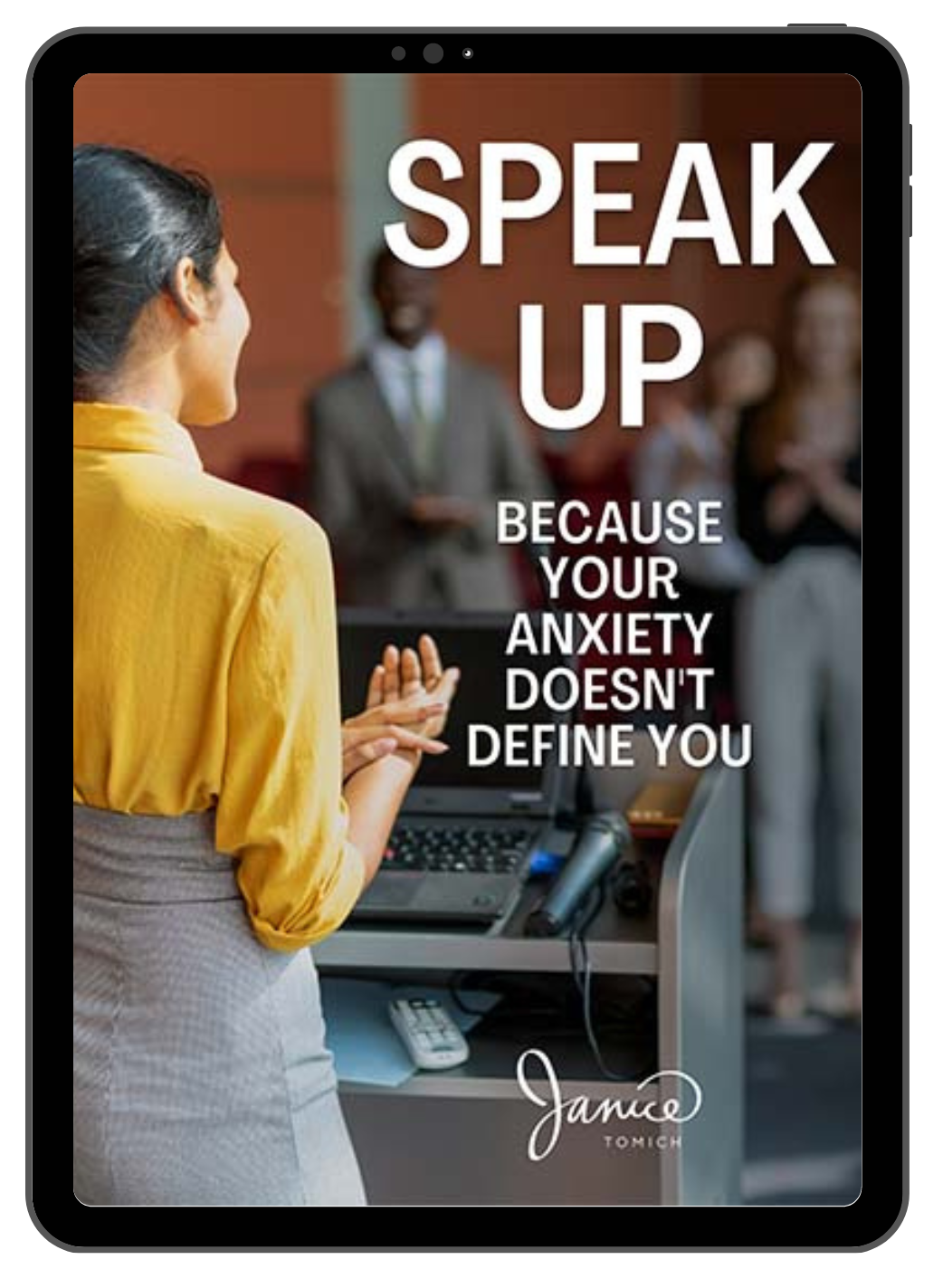Every day, women face barriers at work…
“I’m not heard.”
“I speak up, but my contributions are ignored. Or appropriated.”
“When I’m direct, I’m called a bitch.”
“If I soft pedal, people tell me I’m weak and ineffective.”
I often hear these kinds of statements from my clients.
These statements are barriers to them being promoted.
And they impede them from being perceived as having “executive presence.”
If you’re feeling unheard or misunderstood, I can help.
In my twenties, I optimistically thought that by now women would have reached work parity. That everyone would recognize that leadership presence wasn’t something primarily found among men. Decades later, I realize how mistaken I was.
Female executives (and all women leaders) know the unspoken rule—you’ll walk a tightrope, without a net. Whether personally or systemically, it’s “damned if you do and damned if you don’t.”
There is a lot of work to be done before workplaces are truly fair and equitable for women.
Table of Contents
Women in Executive Positions: The Stats
It’s obvious that women are under-represented in executive and board positions. Women hold just 31% of senior leadership positions globally.
Grant Thornton’s five-year review shows that this percentage is increasing, but a big gap remains.
What is Executive Presence for Women?
Leaders who succeed in executive leadership have two key qualities:
- they are highly skilled, and
- they deliver their vision masterfully.
Stakeholders perceive them as credible, confident and at ease with themselves—all attributes that define executive presence. And any smart, driven woman can accomplish this!
The double bind is that the feedback women often receive is that they lack executive presence, which stalls their opportunities for promotion. It’s a complex issue.
Executive presence is nebulous. It’s hard to put your finger on exactly what it is. Executive presence is subjective. What one person considers to be executive presence doesn’t necessarily align with what others consider executive presence to be. Books on executive presence don’t agree on what it is, either.
How can an executive woman hit the target when it’s moving?
Let’s agree that an executive needs to be persuasive. Executives need to be trusted in the most tumultuous times and seen as the leader who will keep driving when things look dire. Executives need to be tenacious in communicating their vision.
But even if a senior leader has the most brilliant ideas and a solid track record, it’s impossible for them to rise up in the ranks if they’re ignored.
One of the most common issues women seek me out for is help in being heard.
It’s not that they simply feel they’re unheard. They actually aren’t.
They feel trampled over and passed over in meetings.
When they do speak, their words are ignored.
There is a multitude of complaints I hear from my female clients:
- Men dominate meetings and conversations. There is usually one person in the group that self-selects as the person of authority. This person is like a fire hydrant that has an unlimited water supply and won’t turn it off. The hose is usually aimed at women.
- Women tend to lack assertiveness and fail to speak clearly and make their points directly. They dance around issues rather than driving the point home. (Women do this to ensure that they don’t come across too strong, lest they be thought of as a self-centred bitch.)
- A woman will make a point and be ignored. Then, as the meeting moves along, a man will speak to the same point and take credit for the idea.
- A woman has to over-prove her position while being questioned incessantly, whereas a man will often be immediately believed.
- The worst and most egregious complaint? When women are asked to take notes or serve refreshments.
Not giving women an opportunity to shine imposes economic and social penalties. Research conducted by Cuberes & Teignier shows that gender gaps cost the economy 15% of GDP. When an organization has three or more women in senior management positions the company scores higher in every facet of organizational performance.
Hard to imagine, isn’t it?
We have the data, however many people who hold board seats and senior executive positions still have their foot on the door, holding it closed.
The problem is simple yet complicated. When someone holds power, why or how would they be convinced to share it? One would think that simply acknowledging the economic impact would open the door to women. However, the data proves that’s not the case. Power and ego supersede sensibility.
The hard fact is that women are underrepresented in executive leadership positions.
In Canada, where I live, based on Catalyst’s 2019 data, women held only 33.3% of the management positions. The percentage slips even further in senior management roles to 31.5%. Men held over 90% of the C-Level executive roles.
In Canada’s 100 largest publicly traded corporations, women held only 52 of 533 executive office positions.
Canada’s poor corporate performance in equity and inclusion is mirrored by many affluent countries.

A recent post on LinkedIn piqued my curiosity. The author of the post was a young woman entrepreneur building an early-stage startup. She posted an image of herself on LinkedIn with heavily ripped jeans and a short crop top. She said that she will dress as she pleases (which is fine) because no matter how she dresses she has the same amount of intellect and skill (which is true).
She expects that in 2022 organizations need to relax. Organizations need to understand her point of view. Organizations need to understand that young people entering the workforce are resisting stuffy work clothes. She provides an excellent example of a lack of understanding of what professionalism is and what executive presence might be.
On LinkedIn, she received lots of positive and supportive comments, which surprised me more than her viewpoint.
There are wishes and dreams. And then there is reality.
Leaders are expected to have executive presence. To show up looking the part and being the part builds relationships and trust. Yes, there are work environments where the dress code is casual. However, wearing ripped jeans and a crop top to pitch investors or meet with bankers won’t secure the capital needed.
Often the people who can open the gate to the executive suite are men. They base their decisions on their perception and learned biases. Women often receive feedback that they lack that ever-nebulous executive presence. When they query what exactly it is they are lacking, they’re told it’s confidence. Or that they are too assertive.
It’s a landmine of contradictions, but women’s strengths are key to successful organizations.
Women are natural relationship builders. They are usually good listeners. They support their team members, which builds powerful teams. Women often have innate emotional intelligence (EQ) and that helps them have real empathy, giving them insight into what their colleagues are thinking.

Some of the most effective women leaders are introverted. Introverts are keen listeners with high EQ. Introverted women executives aren’t shy, it’s just that they get their energy from quiet and deliberate thinking time. But don’t be fooled, when introverts take the stage they can be a force to be reckoned with (find out how in my introvert’s guide to public speaking).
Change is a decision. Your organization needs to be thirsty to change and realize that the data proves it: An equitable environment is more profitable than one exclusive to men.
In most cases, I’m a proponent of rewarding skills and outcomes. When it comes to gender equality, though, Professor Tomas Chamorro-Premuzic changed my mind. In his article for the Harvard Business Review, Chamorro-Premuzic explains how he also believed in meritocracy, that the cream would rise to the top. But what he learned is that dedication to systemic change is what produces gender equity.
Quotas, although perceived as unfair, are key to making headway to having women in executive roles.
More difficult than instituting quotas is managing obvious and unconscious biases. Gender bias plays a key role in how women are perceived as being executive leadership material. It takes a committed organization to create a fair playing field with people that value fairness over power.
4 Practical Ways Women Can Develop Their Executive Presence
What can a woman do to build her executive presence skills while supporting gender equity for herself and others?
1. Find a sponsor
In recent years, women have been advised to find a sponsor, not just a mentor that advises or coaches. A sponsor is someone who will stand up for you, make introductions, put your name forward for promotions, new job opportunities, or high-profile projects. It’s worth the investment in time and building relationships to find the right person to be your sponsor, to help you build your executive presence.
2. Work where you are valued
I know that this recommendation comes from a privileged place but find employment where you are valued. Seek out situations where your skills are recognized. Right now, in 2022, the labor market favors employees. If you’re looking for a new position or promotion, it’s the perfect environment to acquire rewarding and lucrative senior positions.
3. Ask
Be bold and ask. In the initial stages of my work with the female clients who hire me, they often express that they have trouble asking for what they want and need. They have played out in their mind (many times on repeat) all the reasons why they expect to get a “no.”
It’s gratifying, months after working together, to hear about all the opportunities they asked for and instead received a resounding “yes” to.
4. Speak up
And finally, take a leap of faith and speak up in meetings. You’ll likely be surprised what happens when you consistently share your point of view at meetings and represent your company by speaking at conferences and events.
My clients often start hearing words in their feedback that speak to their developing executive presence—they’re described as being trusted, transparent, authentic, credible, confident, present, and poised. (This is when they realize that the nasty things that their inner gremlin said about their lack of leadership skills and smarts simply weren’t true.)

We’ve Come a Long Way…
A feminist slogan from the 70’s was, “You’ve come a long way baby”.
In the 1970s, women certainly had “come a long way.” Five decades later, we’re still making progress—but there is still a long way to go before women have equitable representation in senior leadership positions.
Part of that process needs to include knocking down the polarizing definition of executive presence. Executive presence needs to be put on an equal playing field which everyone can access.
With initiatives such as #breakthebias I know it won’t take another five decades.
References:
Cuberes, D., & Teignier, M. (2016). Aggregate Effects of Gender Gaps in the Labor Market: A Quantitative Estimate. Journal of Human Capital, 10(1), 1–32.https://doi.org/10.1086/683847 and
Ferrant, G. and A. Kolev. (2016), Does gender discrimination in social institutions matter for long-term growth?: Cross-country evidence. OECD Development Centre Working Papers, No. 330, OECD Publishing, Paris, https://doi.org/10.1787/5jm2hz8dgls6-en


